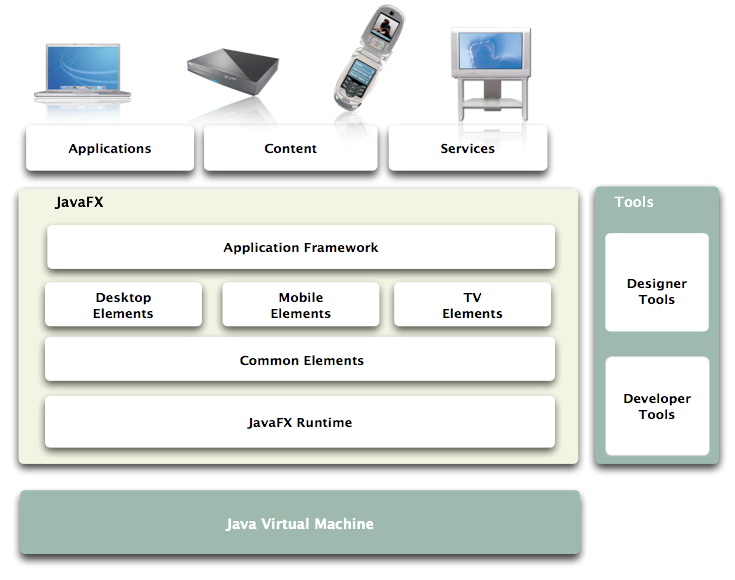JavaFX API Overview
The JavaFX tm Platform is a rich client platform for cross-screen rich internet applications (RIA) and content. It consists of common elements (2D graphics, Animation, Text and Media) and device specific elements for desktop, mobile and TV. The JavaFX common set of APIs allow source level portability of the common set of functionalities across all platforms supported by JavaFX. The JavaFX Runtimes targeted for different devices will ensure consistency and fidelity for content created based on the JavaFX Common APIs. The JavaFX Common APIs will continue to evolve to match more powerful, common capabilities on the various device types.

What you can build with JavaFX:
Cross Platform Applications: If you want to develop a RIA across screens then you need to use JavaFX Common APIs only. The JavaFX Common APIs currently support 2D Graphics, Animation and Text across all platforms. In future, there will be support for audio, video, networking, local storage and other relevant components in JavaFX Common.
Desktop Applications: If you are designing a desktop only application ( Windows and Mac are currently supported) you can extend the functionality of the JavaFX applications by using APIs that are optimized for the desktop in addition to JavaFX Common. This will allow your application to adapt to a desktop look and feel with the JavaFX Swing extensions and also take advantage of Device Media Frameworks and advanced graphics support.
| javafx.application |
The |
| javafx.animation |
A value that can be interpolated. |
| javafx.ext.swing |
The |
| javafx.input |
Set of key codes for KeyEvent objects. |
| javafx.lang |
A DeferredTask represents an action that should be executed at a later time of the system's choosing. |
| javafx.scene |
A class to encapsulate the bitmap representation of the mouse cursor. |
| javafx.scene.image |
The |
| javafx.scene.paint |
NOTE: this definition, while correct, contains a lot of information which is irrelevant to most developers. |
| javafx.scene.transform |
The |
| javafx.scene.layout | |
| javafx.scene.geometry |
The |
| javafx.scene.text |
The |
| javafx.scene.media |
The |
| javafx.scene.effect |
An effect that blends the two inputs together using one of the
pre-defined |
| javafx.scene.effect.light |
Represents a distant light source. |
| javafx.util |
Utility class for localizing strings using JavaFX properties files. |